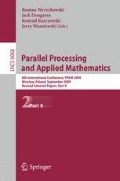Abstract
Increasing demand for computational power in contemporary constructions has created the need to build faster CPUs and construct more efficient algorithms. In this context especially the concurrent algorithms seem to be very promising. Depending on the number of available CPUs they may offer significant reductions in computation time.
In this article two concurrent algorithms of potential field generation are proposed. They present two different approaches to problem domain partitioning called by the authors respectively as tearing and nibbling. It is shown that depending on the problem topology either Tear algorithm or Nibble algorithm is faster. Conclusions are summed up in form of experimental results presenting how the algorithms work in practice. However algorithms construct a discrete potential field according to some specific scheme, there should be no major problems with generalization them to other potential field schemes.
Access this chapter
Tax calculation will be finalised at checkout
Purchases are for personal use only
Preview
Unable to display preview. Download preview PDF.
References
Geraerts, R., Overmars, M.H.: The Corridor Map Method: Real-Time High-Quality Path Planning. In: Proceedings of International Conference on Robotics and Automation, ICRA (2007)
Heinemann, P., Becker, H., Zell, A.: Improved path planning in highly dynamic environments based on time variant potential fields. VDI BERICHTE (2006)
Wang, Y., Chirikjian, G.S.: A new potential field method for robot path planning. In: Proceedings of International Conference on Robotics and Automation (2000)
Barraquand, J., Langlas, B., Latombe, J.C.: Numerical potential field techniques for robot path planning. IEEE Trans. Systems, Man and Cybernetics (1992)
Kretz, T., Bonisch, C., Vortisch, P.: Comparison of various methods for the calculation of the distance potential field (2008)
Dudek-Dyduch, E., Wąs, J.: Knowledge representation of Pedestrian Dynamics in Crowd. In: Rutkowski, L., Tadeusiewicz, R., Zadeh, L.A., Żurada, J.M. (eds.) ICAISC 2006. LNCS (LNAI), vol. 4029, pp. 1101–1110. Springer, Heidelberg (2006)
Treuille, A., Cooper, S., Popović, Z.: Continuum crowds. In: Proceedings of International Conference on Computer Graphics and Interactive Techniques (2006)
Murphy, R.R.: Introduction to AI Robotics. MIT Press, Cambridge (2000)
Behring, C., Bracho, M., Castro, M., Moreno, J.A.: An algorithm for robot path planning with cellular automata. In: Proceedings of the Fourth International Conference on Cellular Automata for Research and Industry (2000)
Xiaoxi, H., Leiting, C.: Path planning based on grid-potential fields. In: Proceedings of International Conference on Computer Science and Software Engineering (2008)
Flynn, M.: Some computer organizations and their effectiveness. IEEE Transactions on Computers (1972)
Lea, D.: Concurrent Programming in Java. In: Design Principles and Patterns, 2nd edn. Addison-Wesley Longman Publishing Co., Inc., Amsterdam (1999)
Author information
Authors and Affiliations
Editor information
Editors and Affiliations
Rights and permissions
Copyright information
© 2010 Springer-Verlag Berlin Heidelberg
About this paper
Cite this paper
Kułakowski, K., Wąs, J. (2010). Two Concurrent Algorithms of Discrete Potential Field Construction. In: Wyrzykowski, R., Dongarra, J., Karczewski, K., Wasniewski, J. (eds) Parallel Processing and Applied Mathematics. PPAM 2009. Lecture Notes in Computer Science, vol 6068. Springer, Berlin, Heidelberg. https://doi.org/10.1007/978-3-642-14403-5_56
Download citation
DOI: https://doi.org/10.1007/978-3-642-14403-5_56
Publisher Name: Springer, Berlin, Heidelberg
Print ISBN: 978-3-642-14402-8
Online ISBN: 978-3-642-14403-5
eBook Packages: Computer ScienceComputer Science (R0)

